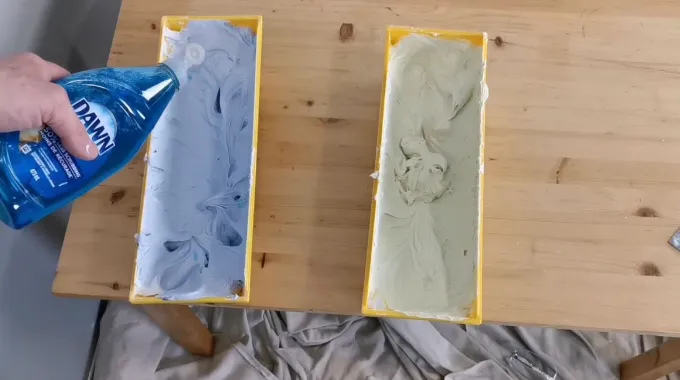Last Updated on March 5, 2023
Did you know that pro drywall finishers have a secret weapon to get their walls looking flawless? They add dish soap into the mix. But why is this so effective, and what benefits does it offer?
When used in the right amounts, dish soap can help give the mud a firmer and smoother feel. Plus, it helps with sanding, shrinks drying time, and gives added resistance to mold & mildew, making your project durable.
Ready to strengthen your drywall mud? Just be careful not to go overboard, though as too much of this stuff will leave you paying more for repairs than desired.
Let’s talk about the best way to use drywall mud for optimal strength and what too much dish soap looks like in action.
Why Put Dish Soap in Drywall Mud: All the Reasons
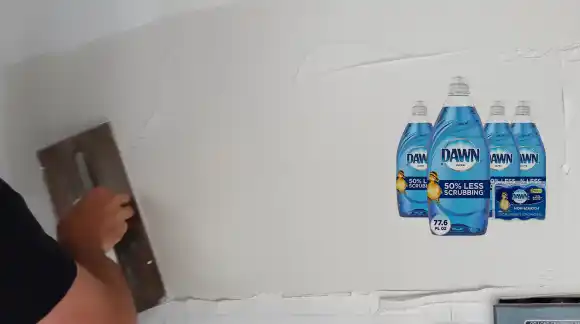
The use of dish soap in drywall mud is becoming increasingly popular among builders and do-it-yourselfers due to its wide range of benefits.
The dish soap helps to create a smoother and cleaner finish, reduces bubbling and pockmarks of drywall mud, makes sanding easier, reduces shrinkage of drywall mud, and more.
1. Create a Smooth Coating on the Wall:
Adding a small amount of dish soap to drywall mud creates a smooth coating on the wall that minimizes imperfections and bubbles. This helps prevent unevenness when applying the drywall mud and improves its appearance overall.
Sheetrock sheets and their joints adhere more securely to wall studs and other components with the soapy mixture.
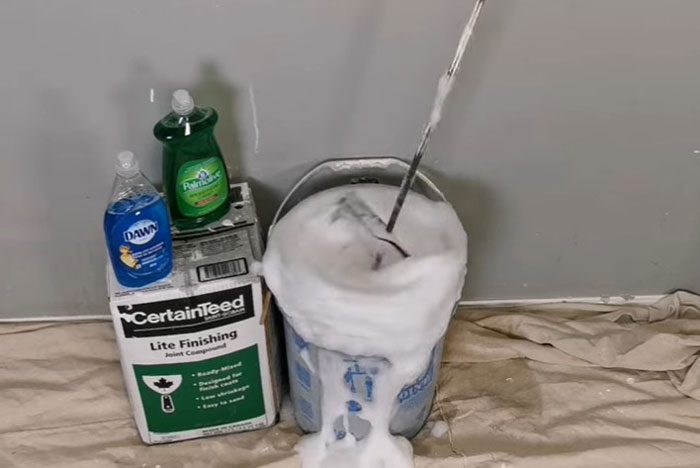
The combination of soap with water also gives an extra level of lubrication which helps spread the mud evenly across surfaces for a much smoother finish.
2. Reduces Bubbling and Pock Marks of Drywall Mud:
The presence of dish soap in drywall mud reduces bubbling and pock marks in walls due to its ability to reduce surface tension between the wall surface and mudding compound, allowing for a smoother application that produces fewer defects or inconsistencies.
When applied correctly, this can result in a much nicer looking wall after completion since there are fewer imperfections that need sanding or patching afterward.
Additionally, this mixture also makes it easier to fill seams or cracks between joints during installation as well as providing better coverage over larger areas without as much effort required.
3. Makes Sanding Easier When Dry:
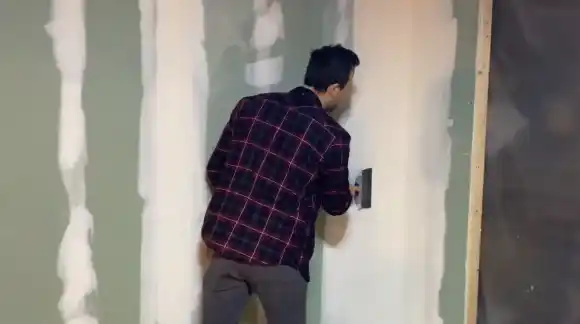
Put some dish soap in your drywall mud, and you’ll get an even softer texture for sanding. This means less time spent taking care of any bumps or lumps after it has dried, as they won’t be nearly as noticeable from the beginning.
The soapy water mixture helps keep the sheetrock in place without sticking too hard or having any slippery surprises, making it a breeze to ensure full coverage with no gaps at all before drying.
4. Reduces Shrinkage of Drywall Mud:
When mixed with dish soap, drywall mud will shrink less when drying compared to traditional mudding alone. This is because the soapy water mix acts like an adhesive that eliminates any air pockets when applied correctly and thus prevents any unnecessary shrinking or cracking once dried up completely.
With minimal effort, you can be sure that no gaps are left in the application, while additional layers may not even be necessary.
5. Reduce Sag and Slump of Drywall Mud:
Adding dish soap to drywall mud can help reduce sag and slump, which can be caused by weight, humidity, or aging drywall joint compound. The laundry detergents found in dish soap act as surfactants that reduce the surface tension on the material, allowing for better adhesion between different layers of drywall mud.
As a result, this helps keep the joints tight and prevents sagging over time, saving time spent on having to go back and re-apply more joint compounds due to poor adhesion.
6. Decrease the Drying Time of the Drywall Mud:
Dish soap also helps decrease drying time for drywall mud drastically compared with just using water alone as a bonding agent between layers. During the installation process, dish soap releases air bubbles faster than water alone because it contains surfactants that break down surface tension on the material.
A quicker drying time also allows for a more efficient installation process as well as reducing labor costs associated with repairs due to shrinkage and other damage caused by long drying times.
7. Increased Mold and Mildew Resistance:
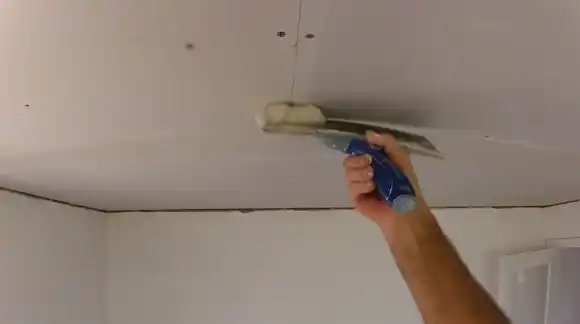
When added to wallboard mud, the surfactants present in dish soap form an invisible force field that prevents mold and mildew from gathering strength.
Water molecules lack their usual ‘stickiness,’ so these nasty bacteria won’t be able to spread easily, giving your surfaces long-term protection with minimal effort on your part.
Further, it keeps your walls and ceilings from rusting from water penetration caused by harmful organisms on drywall mud containing dish soap additives for a long time.
8. Cost Savings:
Using dish soap in your drywall mud is an inexpensive way to add strength and durability to the repair job compared to other options.
The cost savings in using dish soap instead of other additives or products can provide long-term benefits for homeowners on a budget who are looking for an effective solution for their home repair needs.
Dish soap also makes it easier to mix up batches of wall repair compounds, saving time and money by reducing labor costs.
9. Gives the Mud a Pleasant Smell:
The soap is known for its fragrant scent which helps give drywall mud a pleasant odor that won’t overpower any paint or wallpaper that you may be using after the repair job is complete. This can be especially helpful when working in enclosed areas where strong odors could become overwhelming over time.
10. Makes Tools Easier to Clean:
It’s true that dish soap packs a powerful punch, making drywall mud stronger while you work and quickly cleaning up your tools.
You can clean spackle knives, putty knives, and trowels so much easier if you have dish soap handy than if you were just using water or mineral spirits, which can leave behind residue you have to wipe off afterward.
Using dish detergent saves you time and hassle by preventing harmful build-up and residue from building up on your tools.
How Does Dish Soap Cause Drywall Mud Disasters?
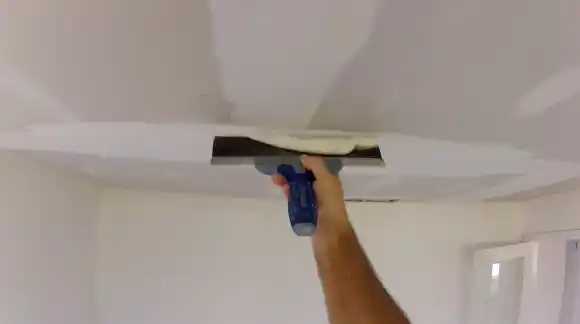
1. Adding Too Much Soap:
When it comes to drywall mud disasters, adding too much dish soap is one of the most common causes. This can happen if a homeowner or contractor is not familiar with the correct ratio of water and soap when preparing the drywall mud mix.
When too much dish soap is added, it can alter the consistency of the mud and make it too thin for use, resulting in a poor finish. Additionally, if too much dish soap is used, it can compromise the adhesion qualities of the drywall mud, ultimately causing cracks and other imperfections in the finished product.
2. Adding Too Much Water:
Adding too much water when making a drywall mud mix can also cause major issues down the road if not taken into consideration properly beforehand.
An excessive amount of water will create a slurry-like mixture that will not have adequate adhesion capabilities once applied to drywall surfaces. This will likely result in weak bonding, which could eventually lead to cracking or crumbling due to a lack of strength between layers.
Furthermore, since too much water has been added into the mix, there won’t be enough absorptive power which means that when dried out, it won’t adhere properly, either leading to further issues such as bubbling or lifting away from wall surfaces after drying completely out.
How To Properly Add Dish Soap To Drywall Mud?
Adding dish soap to drywall mud can make the process of taping and finishing drywall much easier and faster. But you must follow the proper instructions for adding dish soap to ensure optimal performance benefits.
Step 1: Wear Protective Gear:

To stay safe when working with dish soap in drywall mixtures, it’s essential to take all necessary safety precautions. Mask up for air protection and don protective gloves and goggles. This way, you’ll be able to work without putting yourself at risk of skin irritation or inhalation hazards.
Step 2. Starting Small:
When first adding dish soap to your drywall mud, you should start with a small amount. Start by measuring out one teaspoon of liquid dish soap per gallon of drywall mud. After that, stir the two together until they are fully blended together.
We recommend starting with 4-5 tablespoons or 1/4 cup per 5 gallons of drywall mud, as too much can lead to reduced performance benefits.
Step 3. Mixing Thoroughly:
Once you’ve added the appropriate amount of dish soap, thoroughly mix it into the drywall mud using a drywall mud mixer or similar tool. Mix the solution until it is completely blended and has reached an even consistency throughout.
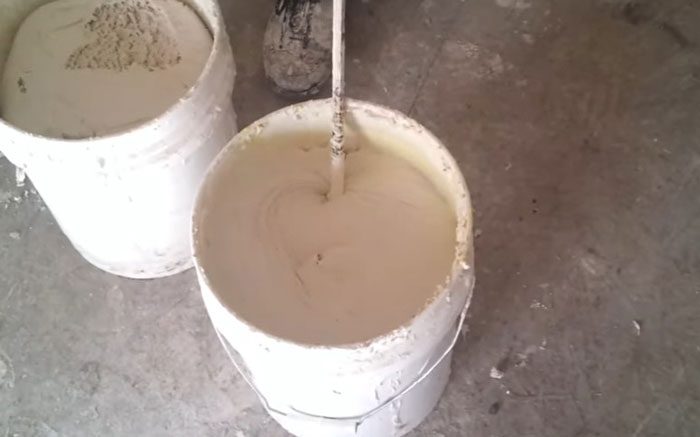
How Do You Make Drywall Mud Stronger?
Drywall mud is a type of plaster mixed with water, paper, or fiberglass, and sometimes glue to create a paste that can be used to cover cracks, fill gaps, and create a smooth surface on walls. To make it stronger and more durable, there are several steps that should be taken.
Thoroughly Mix Drywall Mud Powder
It’s important to thoroughly mix the drywall mud powder until all lumps have been removed. This helps create an even mix that will be easier to apply and provide consistent results.
Add Glue to the Mix
Adding glue to the mix can help give it additional strength and flexibility. The glue helps the drywall mud attach better and stay in place longer than without it.
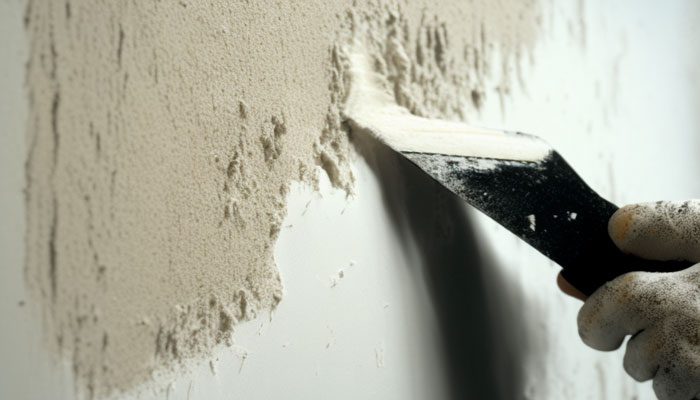
Use Thin Coats
You should apply thin coats when applying the drywall mud instead of thick layers. Applying too much in one spot can cause cracking and warping later on as the drywall mud dries and contracts differently from thinner applications.
Put Tape on the Joints
Adding joint tape on top of each layer can give additional support for areas such as corners or where two pieces meet together.
Signs of Using Too Much Dish Soap in the Mud

Using too much dish soap when making your own drywall mud is a common mistake that can result in some unexpected problems down the line.
Mud is too Smooth:
One sign that you may have added too much soap is if your mixture appears too smooth or has large bubbles within it while mixing or once it’s applied to walls or ceilings. This could indicate that there isn’t enough adhesive within the mixture which could result in weak adhesion to surfaces once dried.
Does not Stand on Drywall:
Your drywall mud does not stand up against gravity when drying on walls or ceilings. This could also mean you added too much dish soap resulting in an unstable form of drywall mud that won’t hold its shape over time.
Can You Use Dish Soap as A Surfactant in Drywall Mud Water?
You can use dish soap as a surfactant in drywall mud water. The dish soap helps to reduce the surface tension of the water, which allows it to mix better with the drywall mud and coat the surfaces more evenly. This helps the drywall mud stick better and gives it a smoother finish.
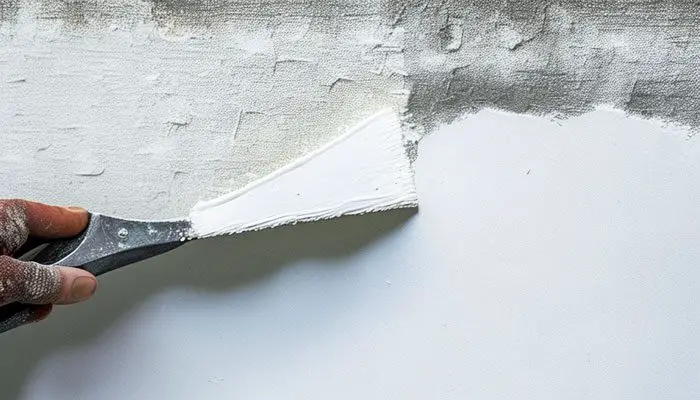
What Causes Fish Eyes in Drywall Mud?
Fish eyes are caused by moisture that cannot be absorbed into the drywall, creating small craters on its surface instead. They are usually caused by high air humidity levels or too much water added to the drywall mud mixture.
To prevent them from occurring, ensure that your work area is well-ventilated and that all surfaces are completely dry before beginning any taping or mudding process.
When taping or mudding, you can also use a small amount of dish soap mixed with your drywall mud. This helps create a smoother finish without leaving behind fish eyes.
Does Dish Soap Destroy Mold on Drywall?
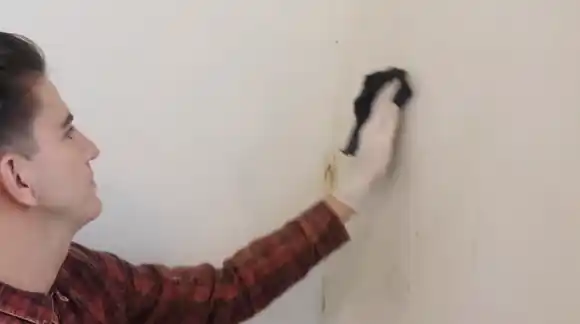
No, dish soap does not destroy mold on drywall but rather removes visible mold from surfaces such as walls or ceilings through cleaning action.
What Does Dish Soap Not Mix with?
It is strongly advised not to mix dish soap with bleach, ammonia, or any other cleanser since these ingredients could react together and create dangerous fumes due to their different pH levels.
Additionally, mixing these products could damage certain finishes on ceramic tile floors or bathroom fixtures due to their strong abrasive nature. Therefore, they should always be used separately if necessary.
Is Dish Soap Good for Drywalls?
Yes, dish soap has properties that can make the mud smoother and more spreadable which leads to a better finish on the wall after painting or staining. It works as an effective lubricant and helps.
Get The Smoothest Finish on Drywall With Dish Soap
Knowing why pros use dish soap when working with drywall mud helps you finish your project smoothly. Adding a small amount of dish soap can help reduce bubbling, shrinkage, and drying time, as well as increase mold and mildew resistance, all factors that contribute towards giving your wall a smooth finish.
However, take caution when doing so as adding too much soap or water can lead to disastrous results that may require additional repairs in order to fix them up again. By following the steps we’ve discussed above, you should be able to get the best out of your next drywall project while avoiding any costly mistakes along the way.
